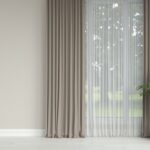Living Room Curtain Ideas | Best Tips for Stylish Room Look
Many regard the living room as the center of the home. It’s the place where visitors are greeted, conversations start, and calm evenings are spent unwinding after a demanding day. Every design choice matters in such a core and very visible area of your house, and your curtains are among the most powerful components in that room. The perfect curtains help to clarify your living room’s character, purpose, and mood in addition to improving its appearance.
Selecting living room curtains is about more than only blocking sunlight at Dubai Window Curtains; it also involves creating atmosphere, matching your décor, and changing your area with both beauty and utility are all about it. Let’s investigate some inspired curtain ideas and professional advice to assist you in designing a really fashionable living room as we move through changing interior trends.
Knowing the Part Curtains Play in Living Room Design
Your living room benefits aesthetically as well as practically from curtains They provide thermal insulation, regulate the amount of natural light, and afford privacy on a practical basis. They act as a design anchor, perhaps even more importantly, tying your furniture, color palette, and placement together in a way that feels intentional and consistent. Your curtains should match the style you see—be it understated and modern or opulent and classic—while still improving the general vibe of the room.
Selecting the Perfect Material for Comfort and Style
The fabric should be among the first factors to think about while choosing curtains for your living area. The texture, weight, and transparency of the curtain fabric greatly influence the way light filters through the room and, therefore, the atmosphere of the space. In airy, open areas, lighter materials such as linen or sheer voile are ideal since they allow in lots of natural light and add a mild, romantic touch. Heavier textiles like velvet, jacquard, or blackout-lined cotton, however, offer grandeur and elegance while also enhancing insulation and noise reduction.
Dubai’s weather also affects the fabric choices. While breathable fabrics during the warmer months help to keep living rooms airy and cool, heavier curtains can provide a welcoming layer of warmth and sophistication in colder months or for homes with great air conditioning. Based on your particular needs and way of life, it’s always a good idea to strike a balance between form and utility.

Matching curtains with Interiors and color schemes
One of the most effective weapons in interior design, color should go with the overall palette of your living room. Bold or highly colored curtains can be used to provide contrast and make a statement in a neutral-toned room. For rooms with bold color schemes already, think about more subdued or matching curtain colors that bring everything together in harmony.
Along with classic colors like navy, ivory, and charcoal, fashionable shades are drawn toward earthy tones like olive green, sandstone, and terracotta. These colors match well in both modern and traditional environments; when matched with the appropriate curtain style, they can quickly enhance the area. Particularly those with botanical, geometric, or abstract patterns that provide visual interest without overpowering the room, patterned curtains are also returning.
The significance of curtains’ length and layering
Your curtains’ elegance and cohesion depend remarkably on length. Floor-length curtains give the living room a sense of elevation and luxury. By contrast, curtains hanging too short can give a room a smaller or unfinished vibe. Because many living rooms in Dubai feature big windows or glass doors leading to balconies, full-length or even puddled curtains are especially popular for their graceful and open effect.
Another fashionable and practical trend is layering. Combining sheer curtains with thicker outer drapes provides you with daytime light control and seclusion flexibility. The sheer let soft daylight fill the room during the day; at night, the heavier layer provides privacy and a more intimate atmosphere. Depth and texture added by this layered appearance help to improve the interior design of the room overall.
Many people view the living room as the center of the house. It’s the area where visitors are welcomed, talks start, and calm evenings are spent unwinding after a busy day. Every design decision matters in such a core and very visible area of your home, and your curtains are among the most powerful components there. The correct curtains define the personality, purpose, and mood of your living area in addition to improving its appearance.
Choosing living room curtains is about more than just blocking sunshine at Dubai Window Curtains; it is about more. It’s about designing an atmosphere, matching your furniture, and changing your room with beauty as well as function. Let’s investigate some creative curtain ideas and expert advice that will enable you to design a really fashionable living room as we approach changing indoor trends .
How Curtains Help Shape Living Room Design
In your living room, curtains are both a useful and visually appealing component. On a pragmatic level, they offer thermal insulation, regulate the amount of natural light, and provide seclusion. They serve as a design anchor, tying your furniture, color scheme, and plan in a manner that seems deliberate and unified, perhaps even more crucially. Your curtains should enhance the general mood of the room, whether you are going for something understated and contemporary or rich and traditional, therefore complementing the design you have in mind.

Selecting the Perfect Fabric for Style and Comfort
Choosing curtains for your living room starts with the cloth. How light permeates the room and how the area appears can be greatly influenced by the curtain material’s texture, weight, and transparency. Lighter textiles like sheer voile or linen in airy, open areas let in lots of sunshine while also adding a soft, romantic touch. Heavier fabrics like velvet, jacquard, or blackout-lined cotton, however, increase drama and refinement while also enhancing insulation and noise reduction.
Fabric selection also depends on the Dubai temperature. While in colder months or for homes with great air conditioning, thicker curtains may offer a comforting layer of warmth and refinement, breathable materials help to keep living rooms cool and light during the warmer months. Based on your unique demands and way of living, it is wise to find a balance between elegance and utility.
Matching curtains with room color themes
One of the most potent weapons in interior design, color should match the color palette of your living space. To contrast and make a statement, if your room has neutral colors, you could use dramatic or strongly colored curtains. For rooms with already vivid color schemes, think about softer or complementary curtain shades that unite everything in balance.
Alongside classic colors like navy, ivory, and charcoal, trendy shades are drawn toward earthy tones like olive green, sandstone, and terracotta. In both modern and traditional environments, these colors work well and can quickly transform a room when combined with the correct drape type. Particularly those with floral, geometric, or abstract designs that provide visual interest without dominating the space, patterned curtains are also returning.
Significance of Layering and Curtain Length
Your drapes appear to be polished and put-together, greatly influenced by length. Floor-length curtains provide the living room with a luxury and height. Curtains hung too short, on the other hand, might give a room incomplete or small. Tall windows make glass doors leading to balconies abound in Dubai homes; hence, full-length or even puddled curtains are often favored for their sophisticated and broad appearance.
Another fashion that is both practical and elegant is layered clothing. Combining sheer inner curtains with more substantial outer drapes lets you change light levels and confidentiality throughout the day. The sheer fabric lets light to enter the room during the day; at night, a heavier layer offers privacy and a more cozy ambience. This layered appearance also improves the texture and depth of the space, hence improving its general design.











